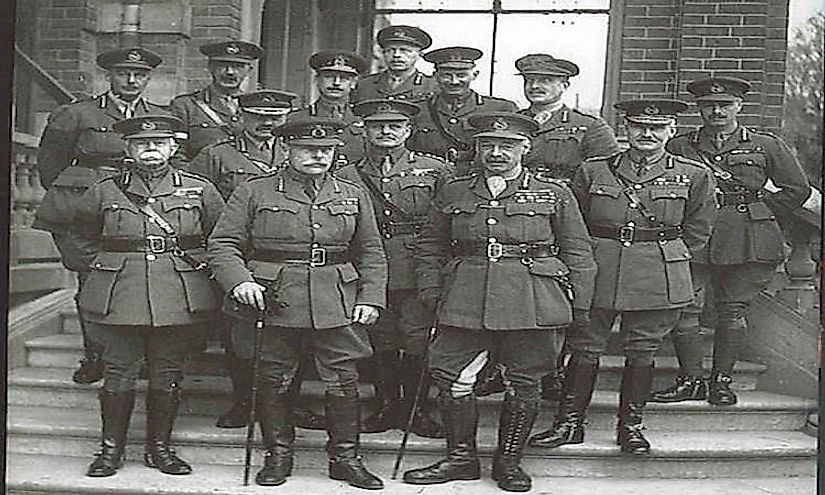Who Led The United Kingdom Through World War I?

World War I took place between 1914 and 1918 during which time the United Kingdom (UK) was part of the Allied Powers which fought against the Central Powers. The UK significantly increased its military size in response to this war by mandating the draft, raising a volunteer army, and investing in the Royal Air Force. Many individuals were involved in the decision to go to war as well as the military tactics employed. This article takes a look at the leaders of the UK during World War I.
Key Leaders During The War
King George V
King George the V was the king of the UK and the British colonies before, during, and after the war which was fought against the German Empire. The German Kaiser of the time was the king’s first cousin. Because of this family connection, the proper titles of the king and his children were of German descent which caused criticisms among British nationals. In 1917, the king officially changed the name of the title to the House of Windsor to garner public support. He visited the fighting front on several occasions, suffering an accident during one of his visits that caused him problems for the rest of his life.
Herbert Henry Asquith
The region changed prime ministers in the middle of the war, Herbert Henry Asquith was the Liberal party’s prime minister during the first half of the war. He was a competent leader during peacetime but proved to be inept at military decisions during the First World War. He was blamed for losing the Battle of the Somme and for prompting an Irish uprising. David Lloyd George, who at the time was the Secretary of State for War, requested more power from Asquith. When this was not granted, David Lloyd George resigned his post which caused Asquith to lose the support of the Conservative party.
David Lloyd George
The Conservative went on to form their own War Committee. Feeling betrayed, Asquith left office and George assumed the position of Prime Minister. Immediately, his goal became destroying the Ottoman Empire and taking control of Jerusalem to gain public support. The Tsar of Russia lost power, seeking refuge in the UK which was not granted by the king; it was George who held the blame for their later execution.
Toward the end of the war, German forces outnumbered British on the western front, and George supported a mandatory draft for Ireland. This, of course, was met with public disapproval. He was accused of lying to Parliament about military issues, an accusation that Asquith stood behind. George defended himself and won House support. While defending his position, he also requested help from the United States Army which sent troops without weapons. The US troops utilized British and French weapons and ammunition, holding back German forces until were without arms. The Allied Powers declared victory on November 11, 1918. David Lloyd George continued as prime minister until 1922.
Several other individuals held positions of power during World War I. Their names, positions, and terms of service are listed below.
Post World War I
Although the economy was able to sustain and even grow in some areas during the war, post-war UK suffered economically. Great Britain, once the world’s largest international investor, became the country with the highest debt. Inflation increased exponentially until 1920 and the value of the Pound fell by just over 60%. The country entered an economic depression in 1929. David Lloyd George remained Prime Minister, enjoying popular support, representing his country at the Versailles Peace Conference, and drafting major social reform policies. King George confronted the sudden demand of his colonies to have the right to self-govern. During the depression, he negotiated a temporary government coalition among the 3 major parties in an attempt to unify the government to overcome the economic turmoil.
Who Led The United Kingdom Through World War I?
| Rank | Leader | Role |
|---|---|---|
| 1 | King George V | King of UK and the British colonies |
| 2 | H. H. Asquith | Liberal Prime Minister of the United Kingdom (1908 to 1916) |
| 3 | David Lloyd George | Prime Minister of the Wartime Coalition Government (1916–22) |
| 4 | Douglas Haig | Commander-in-Chief of the British Expeditionary Force (BEF)(1915–1918) |
| 5 | Sir John French | Commander-in-Chief of the BEF (1914–1915) and Commander-in-Chief, Home Forces (1915-1918) |
| 6 | John Jellicoe | Commanding officer of the Grand Fleet (1914–1916), First Sea Lord (1916–1917) |
| 7 | Horatio Herbert Kitchener | Secretary of State for War (August 5,1914 – June 5,1916) |
| 8 | Sir David Henderson | Director-General of Military Aeronautics (September 1,1913 – October 18, 1917) |







